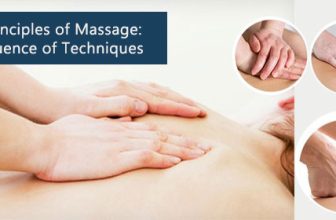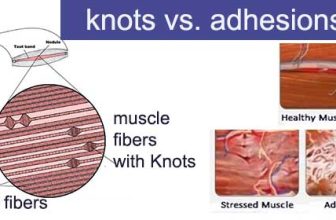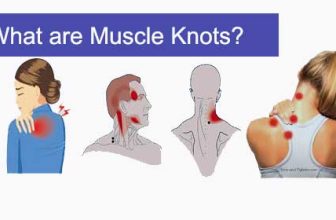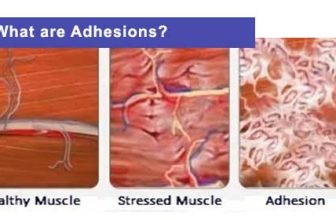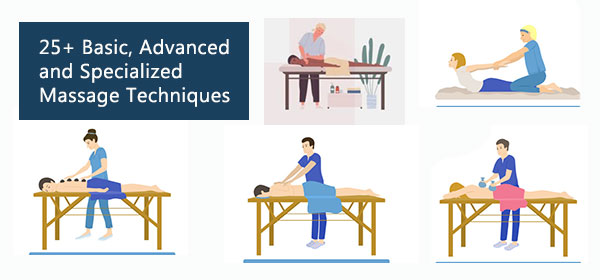
Basic Massage Techniques
Effleurage
Effleurage is a gentle, gliding stroke used in Swedish massage. It involves using the palms, thumbs, and fingertips to apply light pressure and guide along the contours of the body. Effleurage helps warm up the muscles and promotes relaxation and circulation.
Petrissage
Petrissage involves kneading movements using the hands, thumbs, fingers, and forearms. It compresses underlying muscles and can be either superficial or deep. Techniques include kneading, wringing, skin rolling, and pick-up-and-squeeze. Petrissage helps release tension and improve muscle flexibility.
Vibrations
Vibrations are rapid, shaking movements applied to specific areas. They help relax muscles, stimulate blood flow, and reduce muscle spasms.
Rocking
Rocking involves rhythmic movements that gently sway the body. It induces relaxation, relieves tension, and promotes joint mobility.
Frictions
Frictions are deep, circular or transverse movements, using compression and motion applied with fingers or thumbs. This technique is intended to disrupt and break down existing and forming adhesions in muscle fibers, tendons and ligaments, and improve tissue mobility.
Tapotement
Tapotement includes rhythmic tapping, cupping, and hacking movements. It stimulates circulation, invigorates muscles, and energizes the body.
Deep Muscle Stripping
Deep muscle stripping is a technique used to release tension in specific muscle groups. It involves applying deep pressure along the muscle fibers to alleviate tightness.
Advanced Massage Techniques
Tractioning
Tractioning involves gently pulling or stretching specific body parts to improve joint mobility and relieve pressure on nerves.
GTO release
GTO release techniques focus on relaxing muscle tension by stimulating the Golgi tendon organs (proprioceptive nerve receptors that are part of “muscle tension monitoring system”). Direct compression is placed on the tendon near the junction (area of greatest Golgi tendon organ concentration) which will yield the best results.
Origin and Insertion
Understanding the origin (where a muscle begins) and insertion (where it attaches) helps therapists target specific muscle groups during treatment. The origin and insertion technique is a variation of GTO release technique. This is used when the tendon is short. It is also used to reduce spasm and hypertonicity in a muscle when direct work on the muscle belly is uncomfortable.
Muscle Approximation
Muscle approximation involves bringing the ends of the muscle closer together; lessening the stretch on the muscle spindles, which decreases gamma firing, which then reduce muscle tone and spasm.
Myofascial Trigger Point Therapy
Trigger points are treated to alleviate pain and improve range of motion. A variety of massage techniques such as ischemic compressions, repetitive muscle stripping, skin rolling, percussion and stretch and post isometric relaxation are used.
Pressure Point Technique
The pressure point techniques involves compression, then release of painful tissues. The compression creates a temporary local ischemia followed by reactive hyperemia upon release.
Recoil Techniques
Recoil techniques involve quick, controlled movements to release tension in specific areas, such as the rib cage. The amount of pressure varies from light to moderate, depending on the tissue type and amount of restrictions to be reduced.
Specialized Massage Techniques
Manual Lymphatic Drainage (MLD)
MLD involves gentle, rythmic pumping techniques to stimulate lymph flow, reduce swelling, and support the immune system. (Lympatic vessels and lymph nodes remove waste and toxins.)
Craniosacral/ Cranial Sacral Therapy (CST)
Craniosacral Therapy is a gentle therapeutic approach that focuses on the craniosacral system. The craniosacral system encompasses the membranes and cerebrospinal fluid surrounding the brain and spinal cord. CST seeks to release restrictions in this system by manipulating the fascia and joints in the head, spine, and pelvis (sacrum).
Myofascial Release (MFR)
Myofascial release combines soft tissue, craniosacral, and muscle energy techniques. These slow and subtle techniques can be used to release fascia and muscle throughout the body.
Direct Fascial Techniques
The therapist move fascia towards restrictions and adhesions. This technique aims to break down and release the irregular bonds formed between the connective tissue fibers, loosen shortened fascia, and reduce abnormal tension patterns.
Indirect Fascial Technique
To reduce fascial restrictions and adhesions, and increase the slack and flexibility of fascia; the therapist works to move the fascia in the direction of ease (usually the opposite direction of the restriction).
NMT ( neuromuscular therapy)
- St. John Neuromuscular technique combines the elements of connective tissue and Nimmo’s “receptor tonus” techniques to create a system that treats regions of the body.
- Schneider/ Dovrak’s neuromuscular technique uses post-isometric relaxation, agonist and antagonist contraction, joint play and neuromuscular reflex mechanisms to stretch muscles and improve mobility.
Proprioceptive Neuromuscular Facilitation technique (PNF)
PNF uses a combination of passive stretching and isometric contractions. This technique is used to break neuromuscular holding patterns which help increase range of motion, reset muscle holding patterns and increase muscle length.
Rythmic Mobilizations
A series of passive rocking and shaking movements is used to mobilize joints and “reduce stiffness”. The patient’s own rhythm is used as a guide to the speed of the movements.
Muscle Energy
Muscle energy technique (MET) is used to normalize motion in the spine (cervical, thoracic and lumbar spine) and the SI (sacroiliac) joint and. The energy of the patient’s contracting muscles is used to make the corrections (instead of the therapist moving the joint).
Counterstrain Technique
The counterstrain technique reduces pain, muscle spasm and hypertonicity of muscles surrounding a joint. The therapist compresses the tender point while the patient is placed in a position that moves the joint/limb away from the pain.
Joint Play Technique
Involves passive joint mobilizations to assess and treat dysfunctional joints. Once the area of dysfunction has been determined, (1) oscillation techniques and/or (2) intermittent stretch is applied to the portion of the joint capsule to be mobilized. The soft tissue surrounding the joint is prepared with massage or heat.
Other Techniques:
Hydrotherapy
Hydrotherapy uses water (hot or cold) to promote relaxation, reduce inflammation, and enhance circulation. Hydrotherapy combines the principles of massage therapy with the healing properties of water. Hydrotherapy primarily focuses on temperature variations to achieve therapeutic effects.
Hot Stone Massage
Combines the soothing power of heated stones with skilled hands-on massage techniques. Smooth, flat, heated stones (usually made of basalt, a volcanic rock) are placed on specific parts of the body.
The therapist may also hold heated stones while massaging using Swedish massage techniques. Cold stones may be used after hot stones to calm blood vessels and soothe the skin.
Gua Sha Massage
Gua Sha massage, also known as scraping or coining, is an ancient Chinese healing technique that involves using a smooth-edged tool to scrape the skin. Gua sha aims to break up stagnant energy (chi) believed to cause inflammation. Using a gua sha massage tool, short or long strokes are applied to stimulate microcirculation of soft tissue, increasing blood flow.
Cupping Therapy
Cupping therapy is an ancient form (Egyptian, Chinese, and Middle Eastern cultures) of alternative medicine that involves placing special cups (made of glass, bamboo, silicone) on the skin for a few minutes to create suction.
In Dry Cupping, cups are placed on the skin, creating suction. In Wet Cupping, light cuts are made on the skin after cup removal, to draw out a small amount of blood.
Shiatsu Massage
A shiatsu therapist applies pressure on the body’s meridians (energy channels) to balance or unblock the flow of energy (qi). While the term “shiatsu” translates as “finger pressure,” therapists may also use palms, elbows, and sometimes feet to apply pressure along energy lines.
Techniques include holding, stretching, tapping, pressure, kneading, and soothing. Shiatsu massage is a form of bodywork that originated in Japan. It integrates traditional Japanese manual therapies such as acupuncture and anma (an old Japanese massage style) with Western medical knowledge.
Thai Massage
Thai massage, aka Nuat Phen Boran uses passive stretching, manipulation, rocking, compression, and application of pressure to specific energy lines (called Sen in Thai) to promote energy flow. The therapist uses their hands, elbows, knees, and feet to compress and manipulate muscles and joints. Thai massage sessions often take place on a mat or futon on the floor.
Reflexology
Reflexology is a practice that involves applying different amounts of pressure to specific points on the feet, hands and in some cases, the ears. These points are believed to link with certain organs or other parts of the body. Reflexologists use hand and foot maps that illustrate points corresponding to specific areas of the body. Reflexology is based on the theory that all areas of the body correspond with and can be mapped onto areas of the hands and feet.
Passive ROM Exercise
Passive range of motion exercises involve the therapist moving a joint without the patient actively contracting their muscles. It helps maintain joint flexibility. This exercise helps people in rehab, bedridden patients, or patients with chronic conditions.
Passive Stretching
Passive stretching is a technique where an external force (such as a therapist, or a prop) applies a lengthening force to a muscle group. Unlike active stretching (where you contract your own muscles), passive stretching keeps the target muscle group at rest.
Facilitated Stretching
Combines passive stretching with client participation to enhance muscle length and flexibility. Facilitated stretching combines active muscle contraction with external assistance for motor learning and to enhance flexibility and improve range of motion. The patient contracts the muscle being stretched (agonist) and the therapist provides gentle resistance/ stretch.
Active Resisted Strengthening
involves active muscle contraction and external resistance. Active muscle contraction: Patient actively contract a muscle group. External resistance: An external force (therapist or resistance bands) opposes patient’s muscle contraction.
